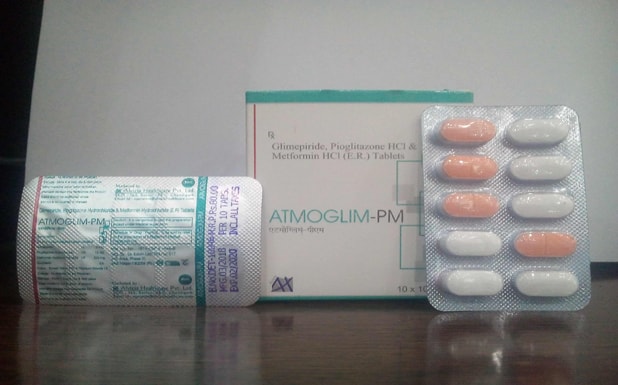
Composition
- Each Tablet Contains:
- Pioglitazone Hydrochloride
15 mg
- Metformin Hydrochloride SR
500 mg
- Glimpride
2 mg
Packing
- 10x10
Blister
MRP
- 77
Overview
Atmoglim-PM contains three anti-hyperglycaemic drugs: Pioglitazone hydrochloride, Glimepiride and Metformin hydrochloride which is used in Type-2 diabete, insulin resistance and obesity. The mechanism of action of Glimepiride in lowering blood glucose appears to be dependent on stimulating the release of insulin from functioning pancreatic beta cells. Pioglitazone is a potent and highly selective agonist for peroxisome proliferator-activated receptor-gamma (PPAR-g). Metformin decreases hepatic glucose production, decreases intestinal absorption of glucose, and improves insulin sensitivity by increasing peripheral glucose uptake and utilization. The combination of glimepiride, pioglitazone and metformin extended-release complement each other and provide better glycaemic control in the management of type 2 diabetes and probably helps in the prevention of diabetes associated macrovascular and microvascular complications.
Indications & Usage
- Diabetes mellitus
- Hyperlipoproteinaemia
- Insulin dependent diabetes mellitus
- Insulin resistance
- Non-insulin dependent diabetes mellitus
Pharmacology
Pharmacodynamic Properties of Pioglitazone Hydrochloride:
Pioglitazone is a thiazolidinedione, antidiabetic agent that depends on the presence of insulin for its mechanism of action. Pioglitazone decreases insulin resistance in the periphery and in the liver, resulting in increased insulin-dependent glucose disposal and decreased hepatic glucose output. Pioglitazone is a potent and highly selective agonist for PPAR-g. PPAR receptors are found in tissues important for insulin action such as adipose tissue, skeletal muscle, and liver. Activation of PPAR-g nuclear receptors modulates the transcription of a number of insulin responsive genes involved in the control of glucose and lipid metabolism. In patients with type 2 diabetes, the decreased insulin resistance produced by pioglitazone results in lower plasma glucose concentrations, lower plasma insulin concentrations, and lower HbA1c values.
Pharmacodynamic Properties of Metformin Hydrochloride SR:
Metformin is an oral antihyperglycemic agent that improves glucose tolerance in patients with NIDDM, lowering both basal and postprandial plasma glucose. Metformin is not chemically or pharmacologically related to any other class of oral antihyperglycemic agents. Unlike sulfonylureas, metformin does not produce hypoglycemia in either patients with NIDDM or healthy subjects and does not cause hyperinsulinemia. Metformin decreases hepatic glucose production, decreases intestinal absorption of glucose, and improves insulin sensitivity by increasing peripheral glucose uptake and utilization.
Pharmacodynamic Properties of Glimepiride:
Glimepiride primarily lowers blood glucose by stimulating the release of insulin from pancreatic beta cells.Sulphonylureas bind to the sulphonylurea receptor in the pancreatic beta-cell plasma membrane, leading to closure of the ATP-sensitive potassium channel, thereby stimulating the release of insulin.
Pharmacokinetics Properties of Pioglitazone Hydrochloride:
Absorption: Rapidly and well absorbed. Peak plasma concentrations of unchanged pioglitazone occur within 2 hours
Distribution: Pioglitazone is extensively protein-bound greater than 99% in serum, principally to serum albumin.Pioglitazone also binds to other serum proteins, but with lower affinity.
Metabolism: Pioglitazone is extensively metabolized by hydroxylation and oxidation; the metabolites also partly convert to glucuronide or sulphate conjugates.
Excretion: Excreted into the bile either unchanged or as metabolites and eliminated in the feces.
Pharmacokinetics Properties of Metformin Hydrochloride SR:
Absorption:It is slowly and incompletely absorbed from the gastrointestinal tract.
Bioavailability:approximately 50% to 60%.
Distribution: Metformin is negligibly bound to plasma proteins. It crosses the placenta and is distributed into breast milk in small amounts.
Metabolism: Metformin is excreted unchanged in the urine. Metformin is not metabolized.
Excretion:min is eliminated by glomerular filtration and tubular secretion.
Half Life:6.2 hours. Duration of action is 8-12 hours.
SIDE EFFECTS
- Nausea
- GI symptoms
- Dry mouth
- Diarrhoea & mild stomach pain
- Headache
DRUG INTERACTION
Certain drugs tend to produce hyperglycemia and may lead to loss of blood glucose control. These drugs include the thiazides and other diuretics, corticosteroids, thyroid products, Miconazole, Phenylbutazone , Danazol, Chlorpromazine, phenytoin, salbutamol, terbutaline.
Contraindications
It should not be taken if you have the following conditions : Type 1 DM, Diabetes Complicated With Ketoacidosis; Hypersensitivity; Severe Renal And Hepatic Impairment.
PREGNANCY & LACTATION
Pregnant and lactating women should take this medication only under the prescription of the physician